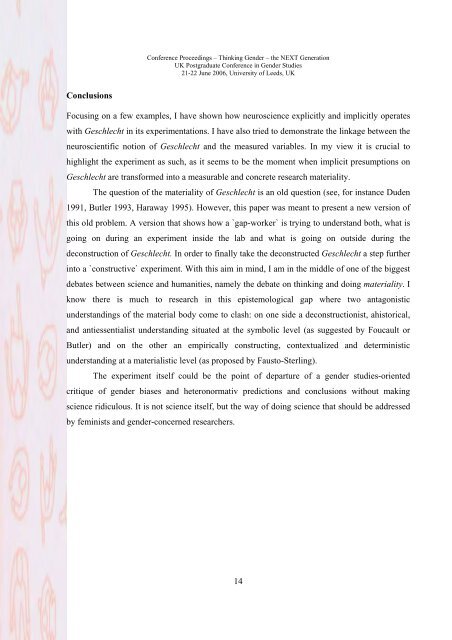On Geschlecht in Brain Science Experiments Anelis Kaiser LSE ...
On Geschlecht in Brain Science Experiments Anelis Kaiser LSE ...
On Geschlecht in Brain Science Experiments Anelis Kaiser LSE ...
You also want an ePaper? Increase the reach of your titles
YUMPU automatically turns print PDFs into web optimized ePapers that Google loves.
Conclusions<br />
Conference Proceed<strong>in</strong>gs – Th<strong>in</strong>k<strong>in</strong>g Gender – the NEXT Generation<br />
UK Postgraduate Conference <strong>in</strong> Gender Studies<br />
21-22 June 2006, University of Leeds, UK<br />
Focus<strong>in</strong>g on a few examples, I have shown how neuroscience explicitly and implicitly operates<br />
with <strong>Geschlecht</strong> <strong>in</strong> its experimentations. I have also tried to demonstrate the l<strong>in</strong>kage between the<br />
neuroscientific notion of <strong>Geschlecht</strong> and the measured variables. In my view it is crucial to<br />
highlight the experiment as such, as it seems to be the moment when implicit presumptions on<br />
<strong>Geschlecht</strong> are transformed <strong>in</strong>to a measurable and concrete research materiality.<br />
The question of the materiality of <strong>Geschlecht</strong> is an old question (see, for <strong>in</strong>stance Duden<br />
1991, Butler 1993, Haraway 1995). However, this paper was meant to present a new version of<br />
this old problem. A version that shows how a `gap-worker` is try<strong>in</strong>g to understand both, what is<br />
go<strong>in</strong>g on dur<strong>in</strong>g an experiment <strong>in</strong>side the lab and what is go<strong>in</strong>g on outside dur<strong>in</strong>g the<br />
deconstruction of <strong>Geschlecht</strong>. In order to f<strong>in</strong>ally take the deconstructed <strong>Geschlecht</strong> a step further<br />
<strong>in</strong>to a `constructive` experiment. With this aim <strong>in</strong> m<strong>in</strong>d, I am <strong>in</strong> the middle of one of the biggest<br />
debates between science and humanities, namely the debate on th<strong>in</strong>k<strong>in</strong>g and do<strong>in</strong>g materiality. I<br />
know there is much to research <strong>in</strong> this epistemological gap where two antagonistic<br />
understand<strong>in</strong>gs of the material body come to clash: on one side a deconstructionist, ahistorical,<br />
and antiessentialist understand<strong>in</strong>g situated at the symbolic level (as suggested by Foucault or<br />
Butler) and on the other an empirically construct<strong>in</strong>g, contextualized and determ<strong>in</strong>istic<br />
understand<strong>in</strong>g at a materialistic level (as proposed by Fausto-Sterl<strong>in</strong>g).<br />
The experiment itself could be the po<strong>in</strong>t of departure of a gender studies-oriented<br />
critique of gender biases and heteronormativ predictions and conclusions without mak<strong>in</strong>g<br />
science ridiculous. It is not science itself, but the way of do<strong>in</strong>g science that should be addressed<br />
by fem<strong>in</strong>ists and gender-concerned researchers.<br />
14


